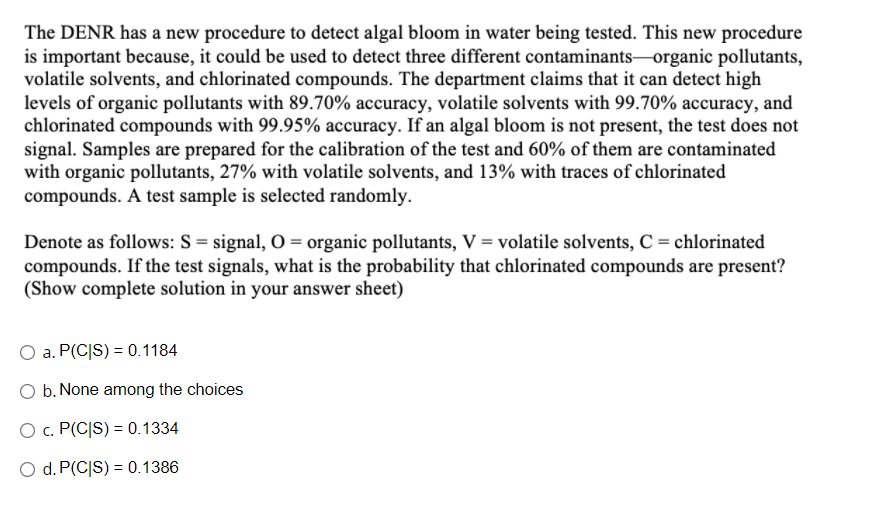The DENR has a new procedure to detect algal bloom in water being tested. This new procedure is important because, it could be used to detect three different contaminants-organic pollutants, volatile solvents, and chlorinated compounds. The department claims that it can detect high levels of organic pollutants with 89.70% accuracy, volatile solvents with 99.70% accuracy, and chlorinated compounds with 99.95% accuracy. If an algal bloom is not present, the test does not signal. Samples are prepared for the calibration of the test and 60% of them are contaminated with organic pollutants, 27% with volatile solvents, and 13% with traces of chlorinated compounds. A test sample is selected randomly. Denote as follows: S = signal, O = organic pollutants, V = volatile solvents, C = chlorinated compounds. If the test signals, what is the probability that chlorinated compounds are present? (Show complete solution in your answer sheet) a. P(C|S) = 0.1184 O b. None among the choices O c. P(C|S) = 0.1334 O d. P(C|S) = 0.1386
The DENR has a new procedure to detect algal bloom in water being tested. This new procedure is important because, it could be used to detect three different contaminants-organic pollutants, volatile solvents, and chlorinated compounds. The department claims that it can detect high levels of organic pollutants with 89.70% accuracy, volatile solvents with 99.70% accuracy, and chlorinated compounds with 99.95% accuracy. If an algal bloom is not present, the test does not signal. Samples are prepared for the calibration of the test and 60% of them are contaminated with organic pollutants, 27% with volatile solvents, and 13% with traces of chlorinated compounds. A test sample is selected randomly. Denote as follows: S = signal, O = organic pollutants, V = volatile solvents, C = chlorinated compounds. If the test signals, what is the probability that chlorinated compounds are present? (Show complete solution in your answer sheet) a. P(C|S) = 0.1184 O b. None among the choices O c. P(C|S) = 0.1334 O d. P(C|S) = 0.1386
Glencoe Algebra 1, Student Edition, 9780079039897, 0079039898, 2018
18th Edition
ISBN:9780079039897
Author:Carter
Publisher:Carter
Chapter10: Statistics
Section10.1: Measures Of Center
Problem 9PPS
Related questions
Question
need solution

Transcribed Image Text:The DENR has a new procedure to detect algal bloom in water being tested. This new procedure
is important because, it could be used to detect three different contaminants–organic pollutants,
volatile solvents, and chlorinated compounds. The department claims that it can detect high
levels of organic pollutants with 89.70% accuracy, volatile solvents with 99.70% accuracy, and
chlorinated compounds with 99.95% accuracy. If an algal bloom is not present, the test does not
signal. Samples are prepared for the calibration of the test and 60% of them are contaminated
with organic pollutants, 27% with volatile solvents, and 13% with traces of chlorinated
compounds. A test sample is selected randomly.
Denote as follows: S = signal, O = organic pollutants, V = volatile solvents, C = chlorinated
compounds. If the test signals, what is the probability that chlorinated compounds are present?
(Show complete solution in your answer sheet)
a. P(C|S) = 0.1184
O b. None among the choices
O c. P(C|S) = 0.1334
O d. P(C|S) = 0.1386
Expert Solution
This question has been solved!
Explore an expertly crafted, step-by-step solution for a thorough understanding of key concepts.
Step by step
Solved in 2 steps with 2 images

Recommended textbooks for you

Glencoe Algebra 1, Student Edition, 9780079039897…
Algebra
ISBN:
9780079039897
Author:
Carter
Publisher:
McGraw Hill

Glencoe Algebra 1, Student Edition, 9780079039897…
Algebra
ISBN:
9780079039897
Author:
Carter
Publisher:
McGraw Hill